The United States plays a vital role in the global cotton market, acting as a key producer and exporter of the fiber. In marketing year (MY) 2019—August 2019-July 2020—the United States produced nearly 20 million bales of cotton, representing about $7 billion in total (lint plus seed) value. Furthermore, the United States is the world's leading cotton exporter, providing approximately 35 percent of global cotton exports in recent years. Through its participation in global trade, the United States supports global textile industries and provides opportunities for domestic farmers to market their cotton to the world.
Cotton is a versatile commodity used in many products, particularly clothing. One bale of cotton—approximately 480 pounds of cleaned cotton lint—can make more than 200 pairs of jeans or 1,200 t-shirts. In the United States and around the world, there are two main species of cotton cultivated for commercial use: upland cotton and Pima (extra-long staple) cotton. Upland cotton comprises the vast majority of production. The primary difference between species is fiber length, with other small differences in growing conditions and end uses.
| Cotton species | Fiber length | Percentage of U.S. production | End uses | Growing conditions |
|---|---|---|---|---|
| Upland (Gossypium hirsutum) | 1" to 1 1/4" | 97% | Apparel, home use (curtains, upholstery, etc.), hospital/medical use | Warm/hot conditions, dry falls, later planting |
| Pima (Gossypium barbadense) | 1 3/8" or longer | 3% | Expensive/high end apparel, sewing thread | Hot, dry conditions, earlier planting |
Domestic Production
U.S. cotton is grown predominantly in 17 southern-tiered “Cotton Belt” States—from Virginia to California. Cotton is planted from March to June and harvested from August to December. Among the U.S. States, Texas is the largest producer, contributing approximately 40 percent of U.S. cotton production in recent years. Other top cotton producers include Georgia, Mississippi, and Arkansas. Within Texas, most production is concentrated in the High Plains region, as cotton is particularly suited for that area’s climate.
Figure 1: Cotton (harvested acres), 2017
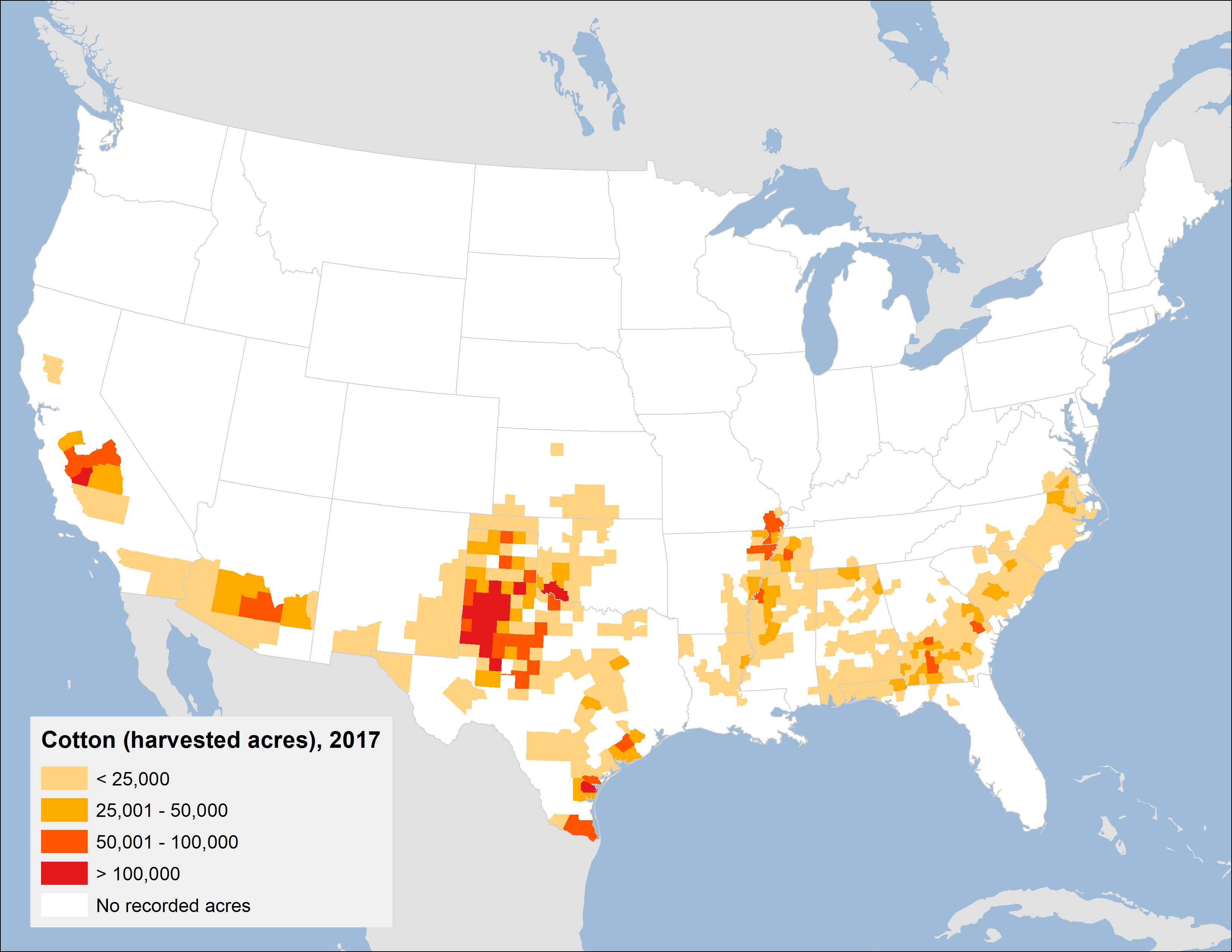
Figure 2: Leading U.S. cotton producing States, 2018-2020
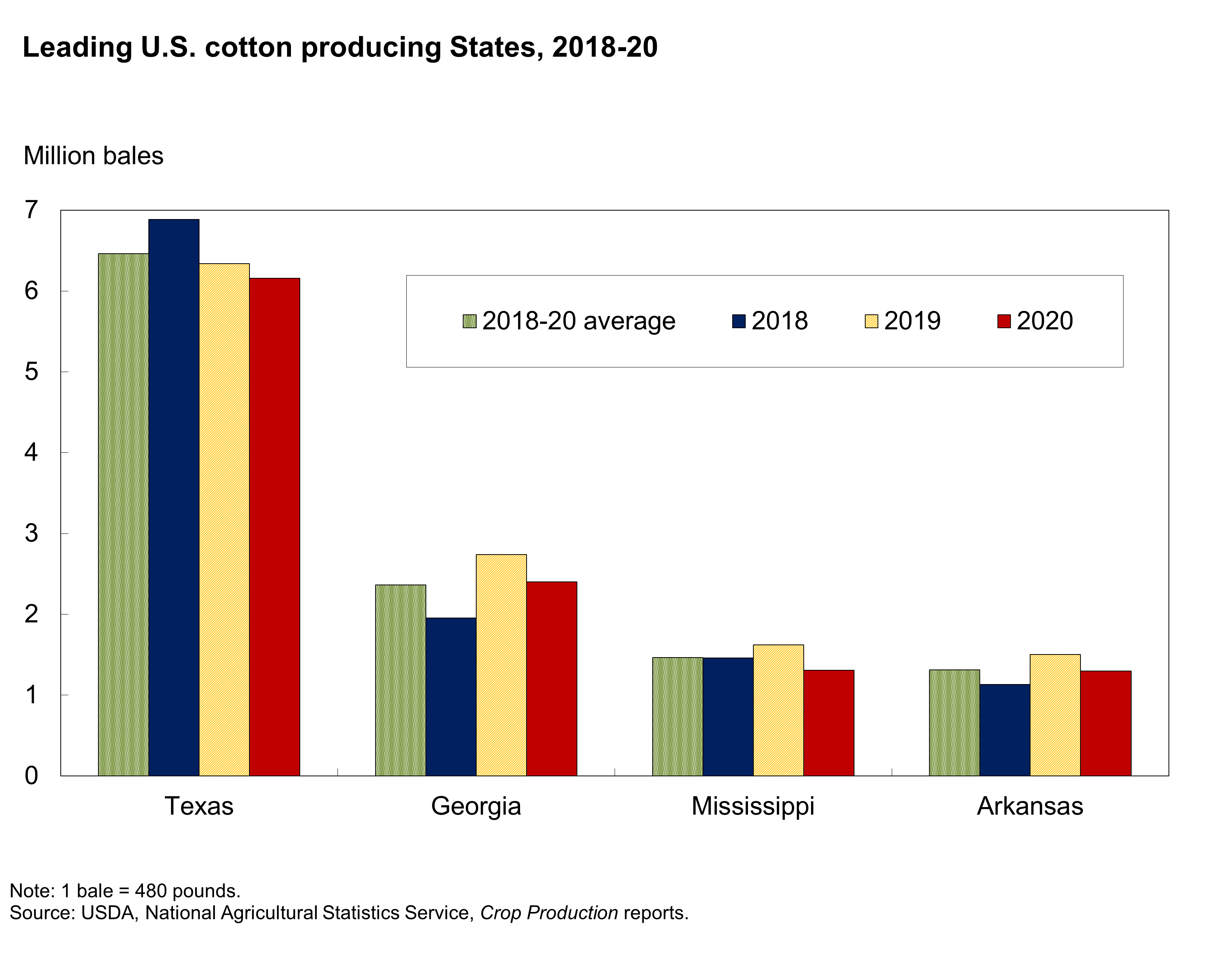
U.S. cotton is mechanically harvested using specialized equipment. Seed cotton—fluffy white fiber that includes seeds—is harvested from the field and pressed into round bales or large modules for transport to a gin. During the ginning process, cotton fibers are separated from the seeds, cleaned of foreign material, and pressed into bales of lint. In the United States, a small sample of cotton lint is collected and sent to a USDA classing office where it is graded, thereby providing the quality characteristics on which the cotton is marketed. After ginning, the cotton bales are ready for shipment—usually to a storage warehouse where bales are consolidated before being sent to a mill for further processing into textile and apparel products.
Policy
Within the United States, the USDA regulates cotton quality and grading. Industry organizations, such as the National Cotton Council, advocate for cotton growers and other cotton industry participants. Government legislation is also a key element for cotton growers in the United States. With the passage of the 2018 Bipartisan Budget Act, for example, seed cotton (unginned cotton) became a covered commodity under the Price Loss Coverage (PLC) and Agriculture Risk Coverage (ARC) programs. These programs continued with the passage of the 2018 Farm Act, the Agricultural Improvement Act of 2018 (see Farm Policy for detailed information). Traditional crop insurance and risk-management programs also help protect farmers from catastrophic and weather-related losses.
Global Supply and Use
Globally, cotton production and consumption can vary considerably, but the long-term upward trend remains. Major factors driving the growth of cotton supply and demand include biotechnology innovations, increasing farm mechanization, population growth, and economic growth. However, the growth is punctuated by periods of sharp decline as seen in recent years. In MY 2015, world production decreased in response to declining Chinese import demand and large global stocks, which lowered cotton prices and incentives to plant cotton. Additionally, in MY 2019, world cotton mill use experienced its largest annual decline as a result of the global economic slowdown.
Figure 3: Global cotton production and mill use, 2004-20

The top two cotton producers, India and China, contribute approximately 45-50 percent of the world’s production, while the top four producers comprise 70-75 percent of global cotton production. Currently, India is the world’s leading producer of cotton, surpassing China recently. Although yields in India are well below the global average, cotton area in India dwarfs that of any other country, accounting for approximately 40 percent of the world total. The United States is the third-largest producer of cotton globally. Since MY 2015, seed genetic improvements and favorable cotton prices compared with other field crops provided a modest rebound in the U.S. crop. Brazil—the fourth-largest cotton producer—experienced a record crop in MY 2019—as cotton there is now produced mainly as a second crop.
Figure 4: Leading global cotton producers, 2010-20
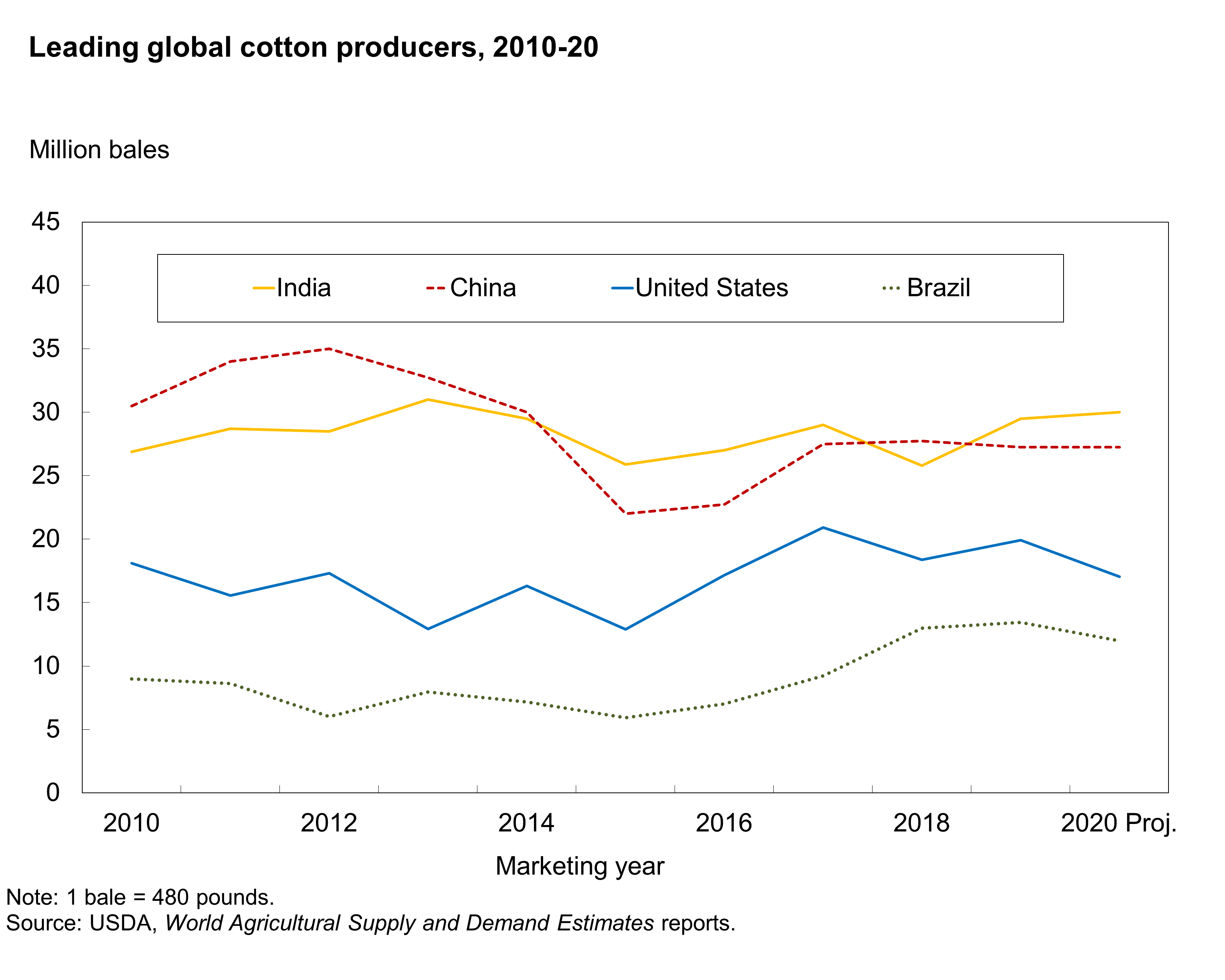
As with production, China and India are the top two users of raw cotton. However, China is by far the world’s leader in processing raw cotton fiber into textiles and apparel. While shifts in Government policy and industry have kept consumption below its peak in the mid-2000s, China still accounts for one-third of global cotton mill use.
India’s cotton consumption is second globally, accounting for about 20 percent of the total, while Pakistan contributes another 9 percent; however, both countries’ share remains relatively stable. In contrast, upward trends in cotton consumption have occurred in Bangladesh and Vietnam, where companies are shifting their manufacturing to countries with relatively cheap labor, thereby increasing their demand for and consumption of raw cotton fiber. Turkey’s cotton mill use has also grown modestly.
Figure 5: Leading cotton mill users, 2010-20
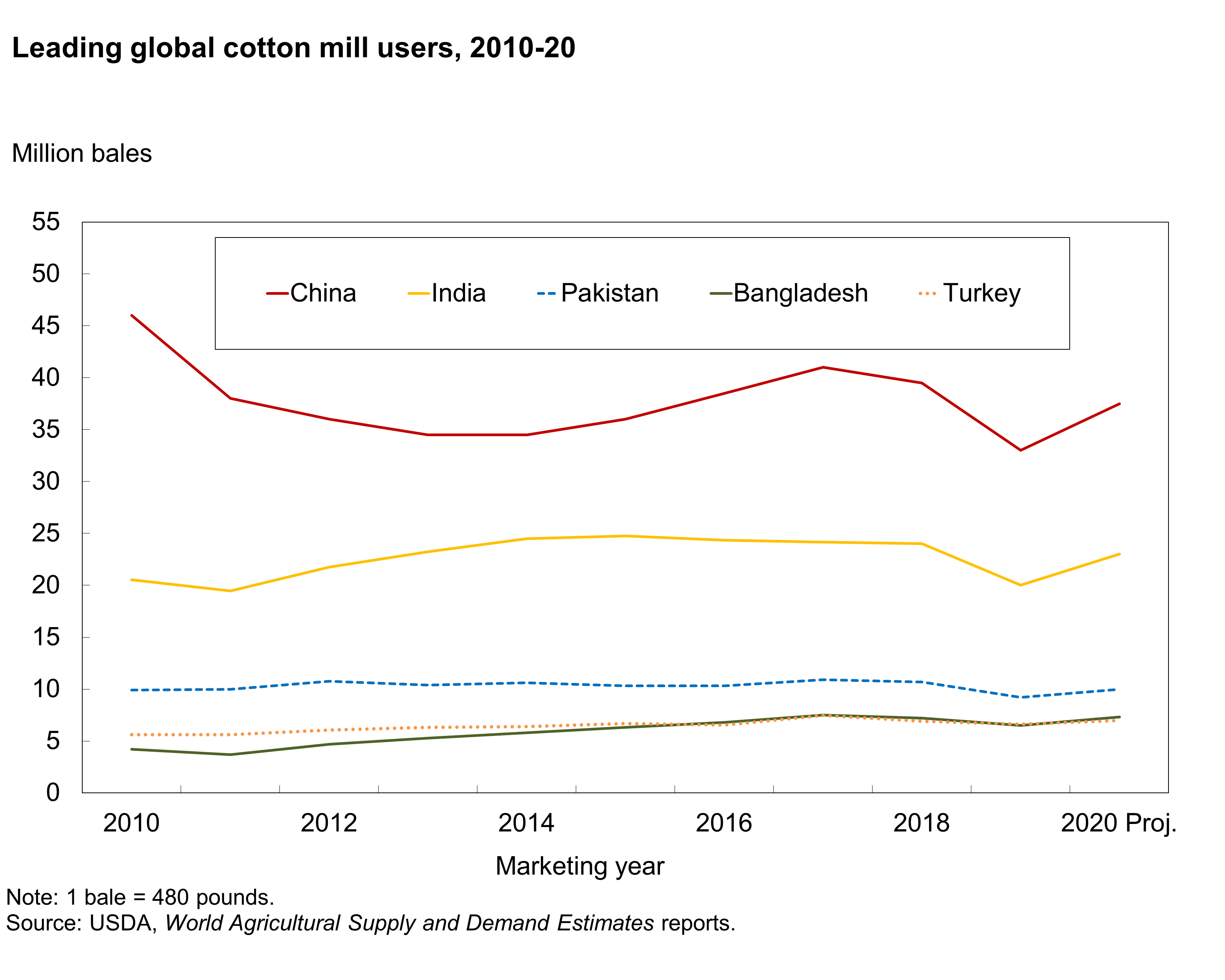
Global Trade
Cotton is a global commodity, with robust trading in raw and finished products. Much of the world’s cotton crosses international borders before finally arriving at its end-use destination, and factors that affect trade and marketing of cotton have far-reaching impacts.
Since China joined the World Trade Organization (WTO) in 2001, textile manufacturing has been a core component of its economic development. Beginning in MY 2010, the Chinese government built strategic stockpiles of cotton to protect its textile industry. This, among other policies, generated a massive demand for foreign cotton, and China became the world's dominant cotton importer. However, China began to phase out these measures in MY 2014 and sell off its stockpile, bringing import levels in line with other countries. In addition to China, the top importers include Bangladesh and Vietnam, where cotton textile and apparel manufacturing has expanded.
Figure 6: Leading global cotton importers, 2010-20
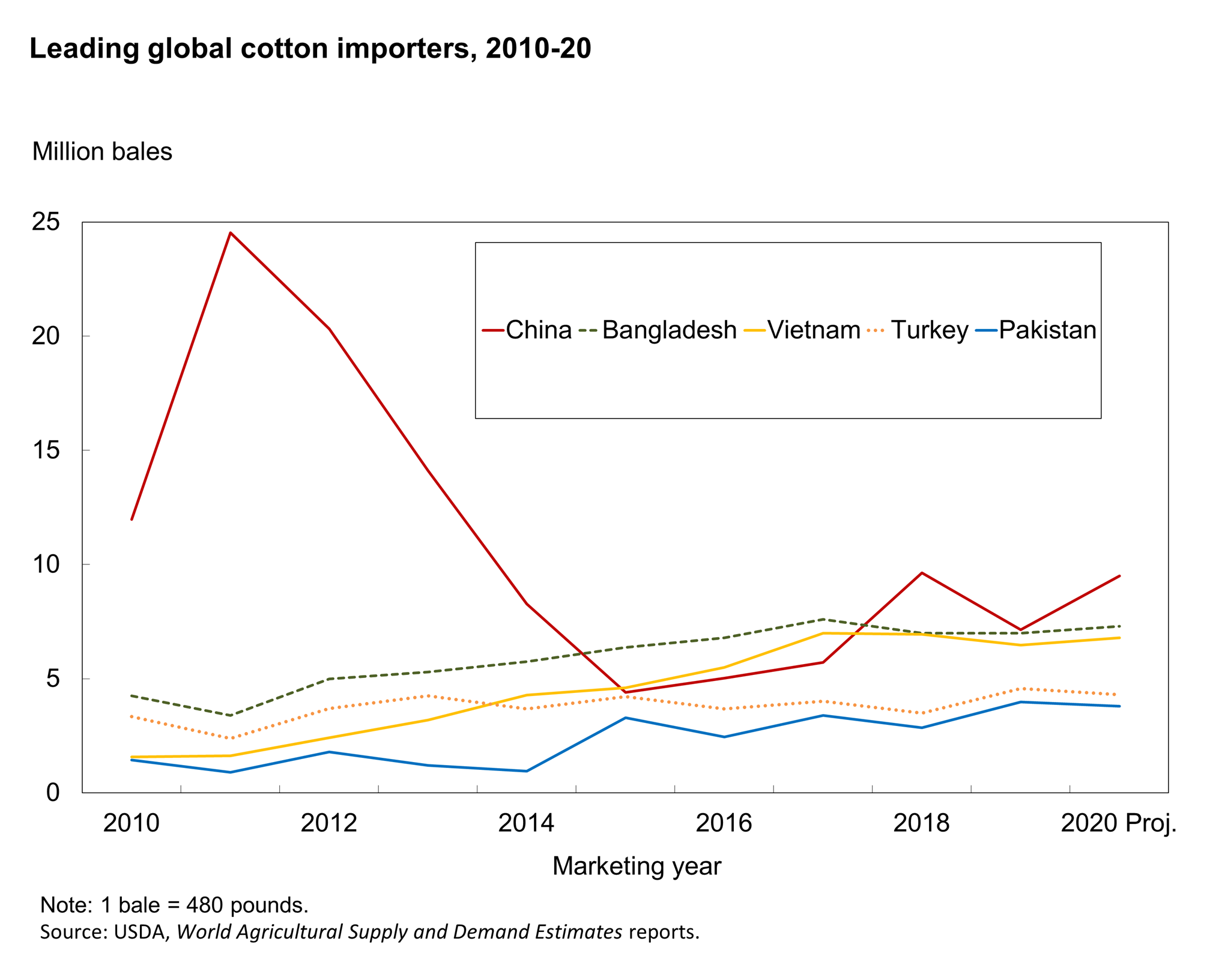
The United States is the leader in global exports, supplying more than 35 percent of the world’s raw cotton export market. In MY 2016, U.S. export levels increased significantly. This change was generated by a high-quality crop, coupled with production decreases from other producers, primarily India and Brazil. U.S. export levels have remained strong since then. However, Brazil—with its recent production increases—has become the second largest exporter to the world, surpassing India in MY 2018. In fact, the United States and Brazil together now account for more cotton exports than the rest of the world combined.
Figure 7: Leading global cotton exporters, 2010-20
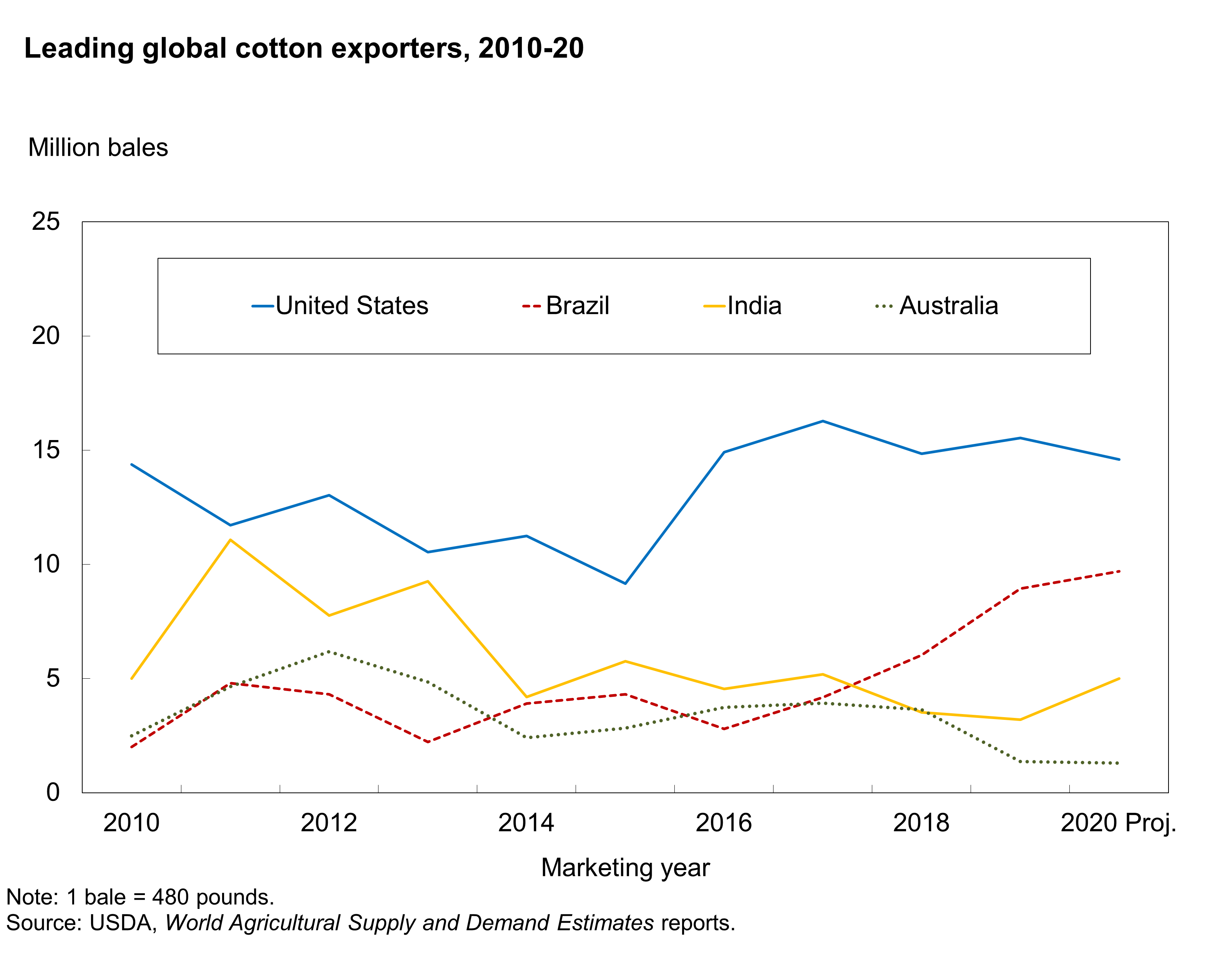
The United States is also a key player in the global trade of cotton goods. While the United States exports much of its raw cotton fiber, it imports the bulk of its textile and apparel products, with China, India, and Bangladesh accounting for over 50 percent of U.S. cotton product imports. Although of a much smaller quantity, U.S. cotton product exports—mainly yarn and fabric—also play a role in global trade. Over 70 percent of these exports go to Honduras, the Dominican Republic, and Mexico for further processing before many of the finished products return to the United States.
World Stocks to Use and Prices
A measure often used to demonstrate the balance between cotton supply and demand is stocks-to-use, the ratio of cotton stocks available to how much is used. Higher stocks-to-use ratios generally indicate lower prices, and vice versa. Cotton prices themselves are often measured by the Cotlook A Index, which is an average of the five cheapest cotton price quotations available for trade around the world.
In MY 2010, cotton prices rose significantly as a result of a combination of factors that drove stocks to unexpectedly low levels and also limited global production increases that year. Both supply and demand responded to the higher prices and the stocks-to-use increased considerably for several years. Beginning with MY 2015, global stocks-to-use decreased as China slowly sold off or used its excessive stocks, and prices increased. However, stocks-to-use jumped to a record in MY 2019, as a large global cotton crop was produced at a time when the global economic slowdown reduced world cotton demand to a 16-year low.
Figure 8: Global cotton stocks-to-use and price, 2010-20
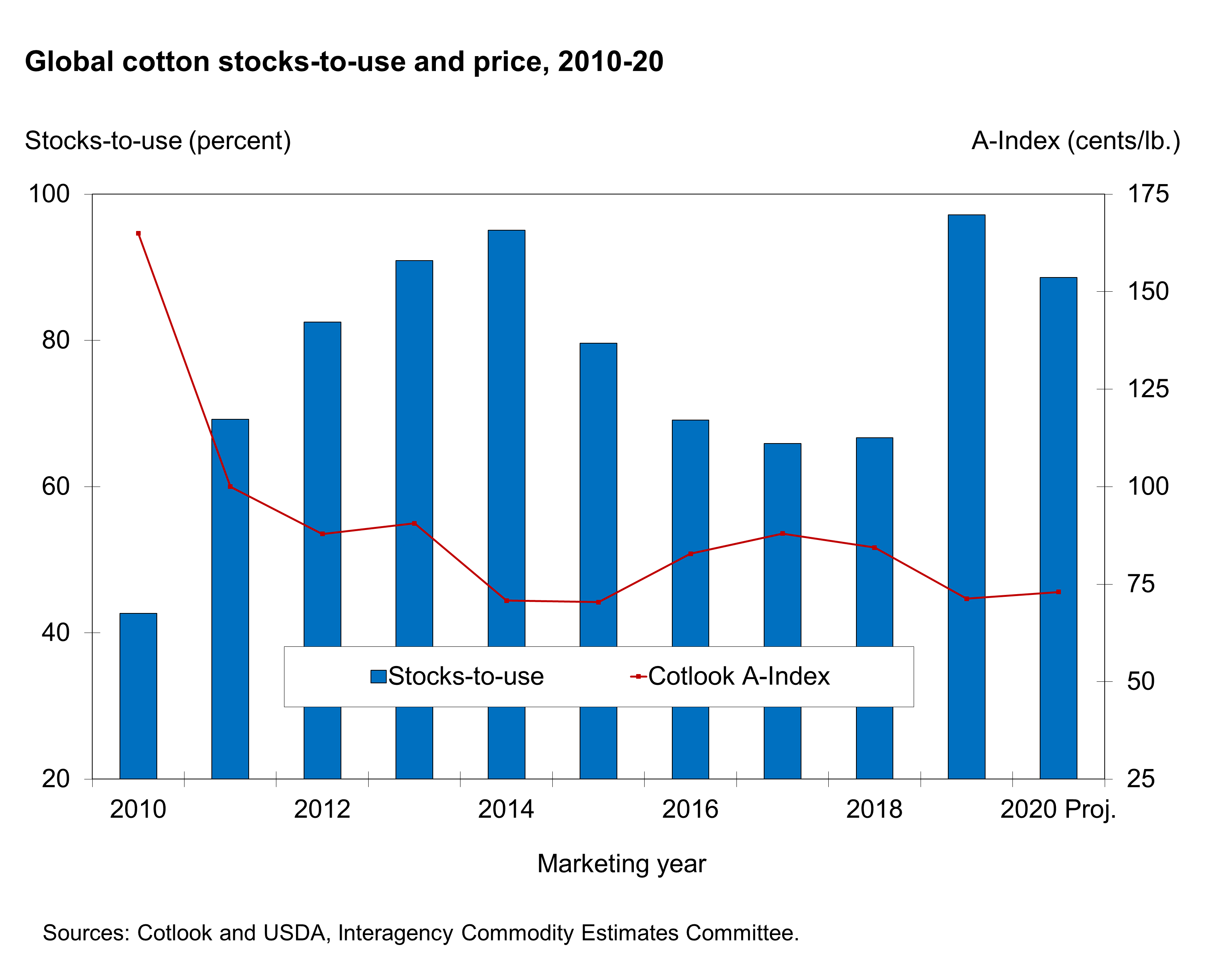
The price of cotton is also determined by other factors. Cotton prices are impacted by the price of other field crops that compete with cotton for area; producers will plant cotton instead of other field crops if it provides a relatively higher return, and vice versa. Common crop alternatives include corn, soybeans, and wheat, though regional crops—such as peanuts—can also be substituted for cotton. The cost of fiber substitutes (particularly polyester and other synthetics) also impacts the price of cotton. If cotton prices rise too high, manufacturers can substitute synthetics for cotton. Given the number and variety of alternatives, cotton producers face stiff price competition and continually operate in a competitive environment.
